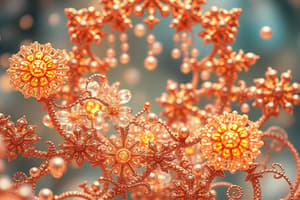Podcast
Questions and Answers
What is a nanometer?
What is a nanometer?
- A unit of length equal to one thousandth of a meter
- A unit of length equal to one billionth of a meter (correct)
- A unit of length equal to one millionth of a meter
- A unit of length equal to one trillionth of a meter
When was the term 'Nanotechnology' defined?
When was the term 'Nanotechnology' defined?
- 1959
- 1981
- 1974 (correct)
- 1985
What is nanoscience?
What is nanoscience?
- Understanding and control of matter at dimensions of 0.1-1nm
- Understanding and control of matter at dimensions of 1000-10000nm
- Understanding and control of matter at dimensions of 100-1000nm
- Understanding and control of matter at dimensions of 1-100nm (correct)
What did the invention of the scanning tunneling microscope lead to?
What did the invention of the scanning tunneling microscope lead to?
What is the width of a human hair compared to nanomaterial shapes?
What is the width of a human hair compared to nanomaterial shapes?
Flashcards are hidden until you start studying
Study Notes
Nanometer
- A nanometer (nm) is a unit of measurement equal to one billionth of a meter (1 nm = 10^-9 meters).
- This scale is crucial in the study of materials and molecules at the atomic level.
Definition of Nanotechnology
- The term 'Nanotechnology' was defined in 1974 by physicist Norio Taniguchi.
- It refers to the manipulation and engineering of materials at the nanoscale, typically ranging from 1 to 100 nanometers.
Nanoscience
- Nanoscience is the study of phenomena and manipulation of materials at the nanoscale.
- It encompasses various fields including physics, chemistry, biology, and materials science.
Invention of the Scanning Tunneling Microscope
- The invention of the scanning tunneling microscope (STM) in 1981 by Gerd Binnig and Heinrich Rohrer enabled visualization and manipulation of individual atoms.
- This breakthrough allowed scientists to explore electronic properties and led to advancements in nanotechnology and nanoscience.
Human Hair vs. Nanomaterial Shapes
- The average width of a human hair is approximately 80,000 to 100,000 nanometers.
- Nanomaterials can have dimensions that are one hundred thousand times smaller than a human hair, typically within the range of 1 to 100 nanometers.
Studying That Suits You
Use AI to generate personalized quizzes and flashcards to suit your learning preferences.




